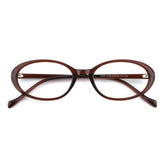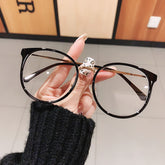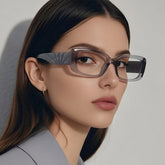How should your Aviator sunglasses fit?
17 Jun 2025
Aviator sunglasses are a timeless classic, known for their sleek teardrop lenses and thin metal frames. Finding the perfect pair isn't just about style—it's about fit, function, and protection.
- How to choose the optimal color for sunglass lenses?
- What are the different types of Aviator sunglasses?
- What are the rules of frame fit?
1. How to choose the optimal color for sunglass lenses?
Different lens tints aren't just about style—they filter light in specific ways to enhance vision and protect your eyes. Here's what each color does best:
- Gray Lenses: They are best for general use, like driving and bright sunlight. Gray lenses can show true color perception and reduce overall brightness without altering contrast, so they are ideal for prolonged wear in strong light.
- Brown/Amber Lenses: They are best for sports, driving, and variable light conditions. Brown/amber lenses can enhance contrast, which is great for spotting terrain changes, block blue light to reduce eye strain, and improve depth perception. So they are helpful for golfers and skiers.
- Green Lenses: They are best for everyday wear and outdoor activities. Green lenses can sharpen visual acuity, provide good color balance (between gray and brown), and reduce glare while maintaining natural colors.
- Yellow/Orange Lenses: They are best for low-light conditions, fog, and night driving. Yellow/orange lenses dramatically boost contrast in dim light and filter blue light (reducing glare from headlights), so they are popular with shooters and cyclists. But they are not suitable for bright sunlight.
- Blue/Purple Lenses: They are fashionable and best for light winter conditions. Blue/purple lenses can reduce glare from snow, add a stylish cool-toned effect, and enhance visual comfort in flat light.
- Red/Rose Lenses: They are best for computer use and overcast days. Red/rose lenses maximize contrast against green backgrounds and reduce eye strain from screens, creating a calming effect.
Tip: Your ideal tint depends on both your activity and eye sensitivity. Those with light-colored eyes often prefer darker lenses for comfort.
2. What are the different types of Aviator sunglasses?
The different types of aviator sunglasses include photochromic, mirrored, polarized, and gradient. These lens variations allow for anyone to find a pair of sunglasses to match their style.
- Classic: Classic aviators refer to sunglasses with UV protection.
- Photochromic: Photochromic lenses can automatically adjust to light conditions.
- Mirrored: These lenses have a reflective optical coating on the outside of the lens resembling a mirror to reflect glare away from the sunglasses rather than letting it in.
- Polarized: Polarized lenses refer to ones that block glare from reflective surfaces while maintaining color balance. They can eliminate reflected glare from water/snow, so they are ideal for fishing and driving.
- Gradient: Gradient lenses have concentrated color at the top and gradually fade to a lighter color at the bottom, stylish while maintaining clear downward vision.
3. What are the rules of frame fit?
- Frame width: The width of the sunglasses should align with the width of your face. When trying on aviators, the frame shouldn’t extend too far beyond the sides of your face.
- Lens coverage: The lenses should fully shield your eyes, including the brow area, without obstructing your vision.
- Nose bridge fit: The nose bridge should sit snugly without pinching your nose. If they keep slipping, consider nose pads or adjustable bridge styles.
- Weight distribution: Aviators are usually lightweight. If they feel heavy, the frame might be too large for your face. Look for titanium or thinner metal frames if you need a lighter feel.
- Temple Grip: The temples should curve slightly around your ears without causing pressure.
- Proportion: Aviators naturally suit most face shapes, but proportions matter. Smaller faces suit classic 55mm–58mm lenses. Larger faces can pull off 60mm+ sizes. The shape should complement your face structure.











